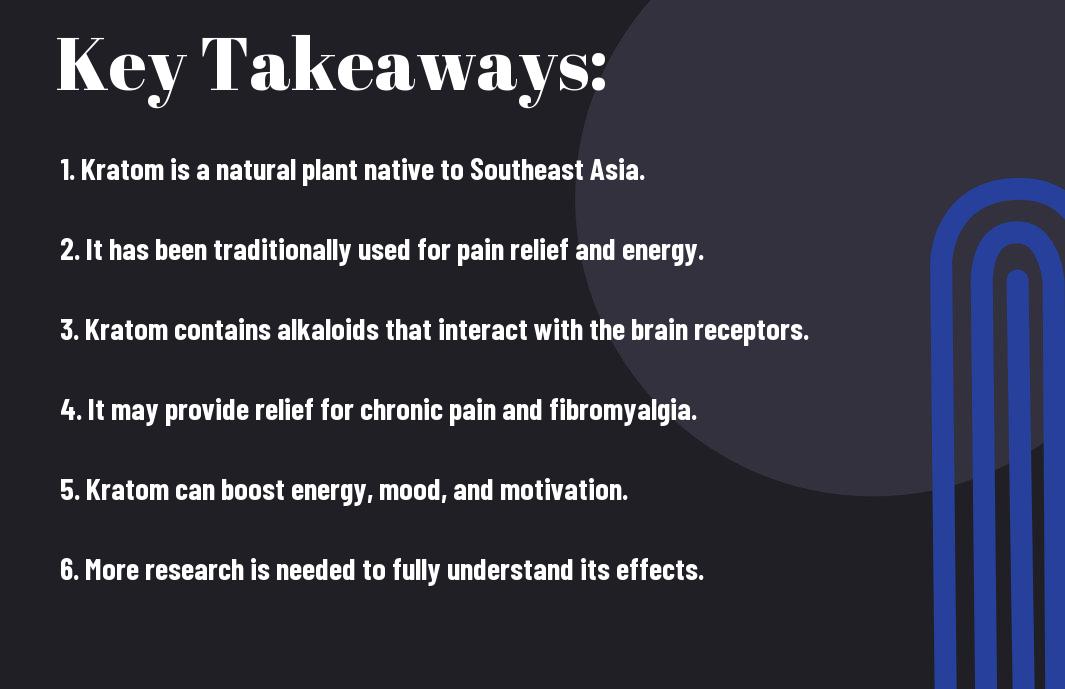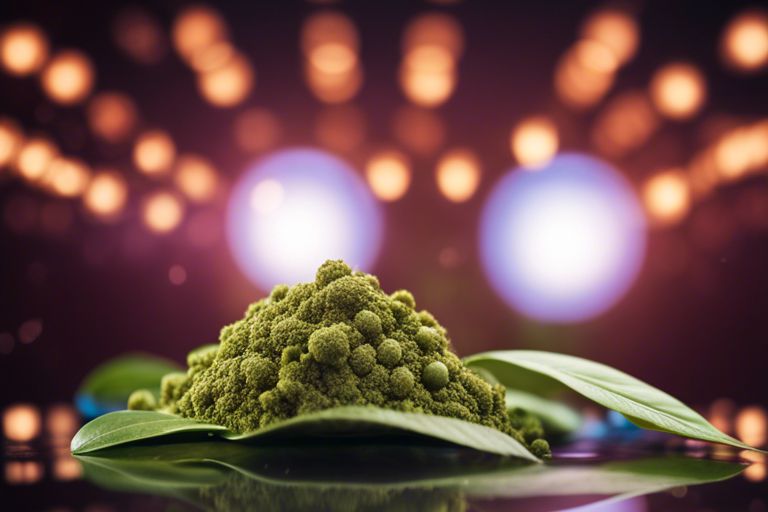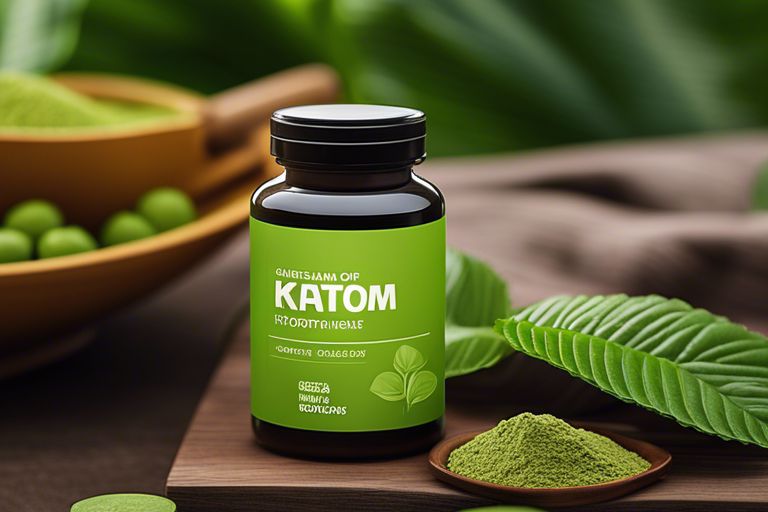Deprecated: mb_convert_encoding(): Handling HTML entities via mbstring is deprecated; use htmlspecialchars, htmlentities, or mb_encode_numericentity/mb_decode_numericentity instead in /home/users/kratomfiles/www/kratomfiles.com/wp-content/plugins/quick-adsense-reloaded/includes/template-functions.php on line 3552
Chronic pain and low energy levels can significantly impact a person’s quality of life, making it difficult to carry out daily activities and enjoy life to the fullest. One demystified substance that has been gaining attention in the wellness community for its potential to alleviate chronic pain and boost energy levels is kratom. Derived from the leaves of the Mitragyna speciosa tree native to Southeast Asia, kratom has been used for centuries for its medicinal properties. However, its scientific understanding and potential benefits for chronic pain management and energy enhancement are still being explored. In this blog post, we will delve into the science of kratom, understanding how it can play a role in reducing chronic pain and boosting energy.
Kratom contains active compounds known as alkaloids, particularly mitragynine and 7-hydroxymitragynine, which interact with opioid receptors in the brain, producing analgesic and energizing effects. Research has shown that these alkaloids have the potential to provide relief from chronic pain by interfering with pain signals and reducing inflammation, making it a notable alternative for individuals seeking natural remedies for pain management. Additionally, kratom has been reported to boost energy levels and improve focus and concentration, making it a potential option for individuals experiencing fatigue or low energy. Understanding the scientific mechanisms behind kratom’s potential benefits can provide valuable insight into its role in holistic wellness and chronic pain management.
Key Takeaways:
- Kratom offers potential for chronic pain relief: Research suggests that the compounds in kratom can help reduce chronic pain, making it a possible alternative to traditional pain medications.
- Kratom may boost energy and focus: Some users report feeling more energized and focused after consuming kratom, which could make it a natural supplement for increasing productivity.
- Understanding the science behind kratom is essential: It’s important to thoroughly research and understand the biological mechanisms of kratom before considering its use for pain management or energy enhancement to ensure safe and effective consumption.

The Botanical Background of Kratom
Some researchers have been studying the health effects associated with Kratom (Mitragyna speciosa) to understand its potential benefits.
Taxonomy and Species
The Taxonomy of Kratom is a subject of extensive research, and its scientific name is Mitragyna speciosa. It belongs to the coffee family, Rubiaceae. There are different strains of Kratom, each with its own unique set of alkaloids and properties, with the most widely known ones being Maeng Da, Bali, Borneo, and Malay.
The Natural Habitat and Cultivation Practices
On its native lands in Southeast Asia, Kratom grows in the tropical rainforests of countries such as Thailand, Malaysia, and Indonesia. Kratom trees require a hot and humid climate to flourish, and they thrive in well-draining soils and shaded environments.
The natural habitat of Kratom plays a crucial role in its alkaloid composition and overall potency. The cultivation of Kratom typically involves manual labor, as the leaves need to be harvested by hand to maintain their quality. The leaves are then dried and processed using various techniques to produce different forms of Kratom, such as powder, capsules, or extracts.

Key Alkaloids and Chemical Compounds
To understand the science behind kratom’s effects on the human body, it is essential to delve into its key alkaloids and chemical compounds. These compounds are responsible for the various therapeutic benefits that kratom offers, including pain relief and increased energy levels.
Mitragynine and 7-Hydroxymitragynine
The two primary alkaloids in kratom, mitragynine, and 7-hydroxy mitragynine, are the key contributors to its potent analgesic and energy-boosting properties. Mitragynine acts as a partial opioid agonist, binding to the opioid receptors in the brain to alleviate pain and discomfort. On the other hand, 7-hydroxymitragynine is even more powerful, offering an enhanced analgesic effect and contributing to the overall energy-boosting properties of kratom.
Other Significant Phytochemicals
An array of alkaloids and compounds present in kratom leaves work in synergy with mitragynine and 7-hydroxymitragynine to produce the plant’s therapeutic effects. These include Speciociliatine, Paynantheine, and Speciogynine, each playing a unique role in enhancing kratom’s pain-relieving and energizing properties. Furthermore, kratom also contains various flavonoids and terpenoid saponins, which contribute to its overall pharmacological activity.
With their combined effects, these compounds make kratom a promising natural alternative for managing chronic pain and boosting energy levels, offering potential benefits for individuals looking for a natural approach to wellness.
Mechanisms of Action
After extensive research, scientists have identified several mechanisms of action that explain the effects of kratom on the body. These mechanisms include interaction with opioid receptors and effects on neurotransmitter systems, which contribute to its role in reducing chronic pain and boosting energy.
Interaction With Opioid Receptors
Any discussion of kratom’s mechanisms of action must include its interaction with opioid receptors. Kratom’s active compounds, particularly 7-hydroxymitragynine and mitragynine, bind to the mu-opioid receptors in the brain, producing analgesic effects similar to those of morphine. However, crucially, kratom does not produce the respiratory depression and addiction potential associated with traditional opioid drugs.
Effects on Neurotransmitter Systems
Any attempt to understand kratom’s role in reducing chronic pain and boosting energy must acknowledge its effects on neurotransmitter systems. By modulating the activity of dopamine and serotonin receptors, kratom can produce mood-boosting and stimulant effects. This contributes to its potential as a natural mental and physical energy booster without the negative side effects associated with traditional stimulants.
Actions on the noradrenergic and GABAergic systems also play a role in kratom’s analgesic effects, providing further insight into its potential as a non-traditional pain management tool.
Kratom in Pain Management
Now, let’s delve into the role of kratom in pain management. Kratom has been used for centuries in traditional medicine to help alleviate various types of pain. It has gained popularity in recent years as a natural alternative to pharmaceutical pain medications.
Types of Pain Addressed
Pain can manifest in many forms, including chronic pain, muscle pain, joint pain, nerve pain, and inflammatory pain. Kratom has been found to be effective in addressing all of these types of pain, making it a versatile option for individuals with different pain conditions. Knowing the specific type of pain you are experiencing can help in determining the most suitable kratom strain for your needs.
| Pain | Types of Pain Addressed |
| Chronic | Muscle |
| Joint | Nerve |
| Inflammatory |
Review of Scientific Evidence
The scientific evidence supporting the use of kratom in pain management is growing. Studies have shown that kratom’s active compounds, such as mitragynine and 7-hydroxymitragynine, have analgesic properties that can effectively reduce pain levels in individuals suffering from various conditions. The mechanism of action involves interactions with opioid receptors in the brain, providing pain relief similar to that of opioid medications without the same level of addictive potential.
Pain relief from kratom has also been linked to its anti-inflammatory and muscle relaxant properties, making it a multifaceted option for individuals dealing with chronic pain conditions. Importantly, the potential for dependence and tolerance with long-term use should be carefully considered and monitored by healthcare professionals.
Kratom and Energy Enhancement
Your search for a natural energy booster may lead you to kratom, a tropical plant native to Southeast Asia. Kratom has gained popularity for its potential to enhance energy levels and provide a natural alternative to conventional stimulants.
Understanding the Energy-Boosting Properties
On a physiological level, kratom interacts with the brain’s opioid receptors, resulting in increased energy and alertness. This is due to the stimulation of adrenaline and noradrenaline production, which are hormones that contribute to heightened energy levels and improved focus. Additionally, kratom’s alkaloids, particularly mitragynine, and 7-hydroxy mitragynine, may play a role in providing a boost of energy without the jitters or crashes associated with synthetic stimulants.
User Experiences and Studies
Any discussion of kratom’s energy-boosting properties would be incomplete without considering the experiences of individuals who have incorporated kratom into their wellness routines. Many users have reported a sustained increase in energy and motivation after consuming kratom, which has propelled them through demanding tasks and workouts. Furthermore, preliminary studies have suggested that kratom may have the potential to enhance physical endurance and alleviate fatigue.
Enhancement of energy levels through kratom is a subject of ongoing research and interest within the scientific community. While individual experiences may vary, it is important to exercise caution and mindfulness when using kratom to boost energy, and to seek guidance from a healthcare professional.

Safety, Legality, and Ethical Considerations
Despite the potential benefits of kratom, it is important to consider the safety, legality, and ethical implications of its use. Exploring the use of Kratom (Mitragyna speciosa) via…
Potential Side Effects and Risks
With any substance, there are potential side effects and risks to consider. Some individuals may experience nausea, dizziness, or drowsiness when using kratom, especially at higher doses. There is also the risk of dependency and withdrawal symptoms for those who use kratom frequently. It is important to use kratom responsibly and in moderation to minimize these potential risks.
Regulatory Status Around the World
Worldwide, the regulatory status of kratom varies. Some countries have strict laws prohibiting its use, while others have more lenient regulations. The effects of these differing regulations are an important consideration for those interested in using or selling kratom.
Effects of kratom regulations can impact access to the substance for individuals seeking alternative pain management or energy-boosting solutions, as well as the ethical considerations of its trade and distribution.
Ethical Issues in Use and Marketing
While kratom may offer potential benefits, there are ethical considerations to be mindful of in its use and marketing. As with any natural substance, it is essential to ensure transparency and honesty in marketing kratom products. It is also crucial to promote responsible and informed use to avoid exploitation or misuse of the substance.
Marketing of kratom products should be approached with integrity and sensitivity to the potential risks and benefits associated with their use.
Can Kratom also be used to boost energy and reduce chronic pain, or is it primarily for weight loss?
Yes, kratom’s weight loss benefits have been widely discussed, but it is also known for its energy-boosting and pain-reducing properties. While some people use kratom to aid in weight loss, its effects on energy and chronic pain relief are equally significant for many users.
What are the potential benefits of using Kratom for chronic pain and energy?
Many people believe that kratom potential side effects are minimal compared to its potential benefits for chronic pain and energy. Kratom is said to have natural pain-relieving properties and can provide a significant energy boost. Some users report experiencing improved focus and overall well-being without the harsh side effects of traditional pain medications.
Can Kratom Consumption Lead to Chronic Pain Relief and Boost Energy?
Consuming kratom may provide chronic pain relief and an energy boost, but it’s important to consider its impact on liver health. Regular use of kratom may lead to liver damage, so it’s crucial to monitor liver function. Seeking medical advice before using kratom can help protect liver health.
Conclusion
Presently, the science of kratom has shed light on its potential role in reducing chronic pain and boosting energy levels. Research has indicated that the active compounds in kratom, such as mitragynine and 7-hydroxymitragynine, interact with opioid receptors in the brain, providing pain relief and enhancing energy levels. However, it’s important to note that more research is needed to fully understand the mechanisms of kratom’s effects and its long-term safety.
In conclusion, while the use of kratom for chronic pain and energy enhancement shows promise, it is essential to approach its consumption with caution and under the guidance of a healthcare professional. Continued scientific inquiry into kratom’s properties and potential benefits will help to provide a clearer understanding of its role in managing chronic pain and boosting energy levels while also ensuring the safety and well-being of individuals who may consider using it for these purposes.
FAQ: The Science of Kratom – Understanding Its Role in Reducing Chronic Pain and Boosting Energy
Q: What is Kratom?
A: Kratom is a tropical tree native to Southeast Asia. Its leaves contain compounds that have psychotropic (mind-altering) effects, and it has been used for centuries as a traditional medicine.
Q: How Does Kratom Help Reduce Chronic Pain?
A: Kratom contains alkaloids such as mitragynine and 7-hydroxymitragynine, which act on the same receptors in the brain as opioids to reduce pain. These alkaloids also have anti-inflammatory properties, further contributing to pain relief.
Q: Can Kratom Boost Energy Levels?
A: Yes, Kratom can act as a stimulant in lower doses, boosting energy levels and combating fatigue. This effect is largely due to the plant’s ability to increase the release of dopamine and serotonin in the brain.
Q: What Are the Risks and Side Effects of Kratom Use?
A: While Kratom may offer potential benefits, it is important to be aware of the potential risks and side effects, which can include nausea, constipation, dizziness, and in some cases, addiction and withdrawal symptoms. Long-term use may also lead to liver damage.
Q: Is Kratom Legal and Safe to Use?
A: The legal status of Kratom varies by country and region. It is important to research and understand the laws and regulations regarding Kratom in your location. As for safety, responsible and moderate use of Kratom may be relatively safe, but it is crucial to consult with a healthcare professional before using it, especially if you have underlying health conditions or are taking medications.









